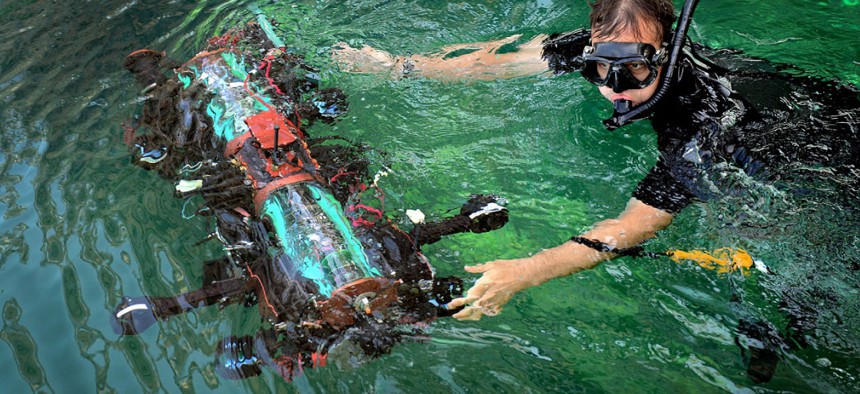Research teams plumb the depths of autonomy with RoboSubs
Schools from around the world join a competition to advance UUV technology and encourage a new generation of engineers.
The Navy has made no secret of its plans for unmanned vessels a big part of its future plans, as evidenced by its plans to comply with the Defense Department’s Third Offset Strategy for using drones of one form or another and its recently held, ninth annual RobotBoat competition for surface vessels.
But operating on the surface is only one part of the game. The Navy sees a lot of potential in what unmanned undersea vehicles, or UUVs, can do for naval operations, announcing earlier this year that it plans to invest $600 million over the next five years in that area. And in the interest of developing those capabilities, the Office of Naval Research recently held its annual RoboSub competition in San Diego, featuring scholastic teams from around the world in a competition to navigate a number of underwater obstacles and perform a number of underwater tasks. ONR sponsored the competition along with the Association for Unmanned Vehicle Systems International Foundation.
Among the tasks the teams, which included high school and universities, had to perform were autonomously navigating a course of PVC pipes, dropping markers—i.e., anchors—within a designated area, displaying the ability to scuttle a surface ship, and finding an object that was emitting a sonar signal, ONR said in a release.
As with its RoboBoat competition for surface vehicles, the competition is essentially about furthering knowledge in an important but still developing, area of technology while also looking to inspire a new generation of engineers. Teams also had to produce websites, videos and journals detailing their research.
“This event allows participants to not only demonstrate their engineering skills, but also their academic knowledge,” said Kelly Cooper, a program officer in ONR’s Sea Warfare and Weapons, Ship Systems and Engineering Research Division. “Both are vital aptitudes for students as they enter into the workforce—naval or otherwise.”
The Navy sees a lot of potential for UUVs, including miner countermeasures, inspecting the hulls of ships, conducting intelligence, surveillance and reconnaissance and serving as communications relays. Navy leaders also have talked about building an underwater network comparable to the Interstate Highway system.
In the RoboSub competition, The California Institute of Technology came out on top, winning the $6,000 first prize. The Indian Institute of Technology Bombay won second and $5,000, followed by Cornell University ($2,000), G.I. Nevelskoy Maritime State University in Russia ($1,500), a team from Kasetsart University and Chulalongkorn University in Thailand ($1,500), Harbin Engineering University in China ($1,000) and McGill University in Montreal ($1,000). More than 30 other teams from high schools and universities also took part in what ONR said was its largest RoboSub competition to date.
“It’s important we continue our involvement in events like this,” Cooper said. “For naval forces, autonomous systems represent a rapidly expanding field, so it’s essential we continue to reach out and connect the needs and interests of the naval community with the engineers of the future.”
NEXT STORY: Engine glitch stalls Navy's MUOS-5 satellite




